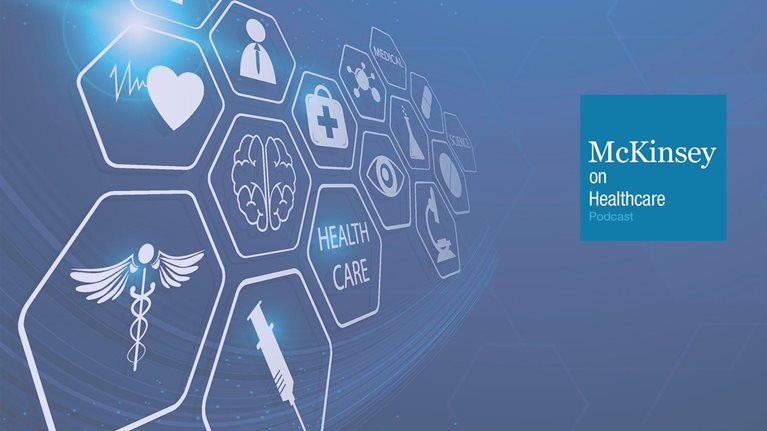DISCLAIMER: The views and opinions expressed are those of the interviewee and are not necessarily those of McKinsey and Company.
Jenny Cordina: So Penny, looking at the big picture, what do you see as the two to three biggest trends affecting health systems such as Allina in today's environment?
Penny Wheeler: One of the trends that everybody speaks to is, of course, this transition in business model, where we're being paid for how many things we do to how many people to how well we do them and at what cost.
As an organization, the latter of how well we do things and at what cost lines up with our mission better. You can create value in both systems, but we think we can create greater value as we move towards that business model. So we're trying to disrupt and even to think about the market rewards.
We've gotten much more deliberate about our contracts with payers and are actually forming a new company with Aetna to drive more of the payment reimbursement for things that don't get paid for today.
Expanding partnerships to increase value
Jenny: Right. And have you found that when you've been working with payers in the market they've been receptive or eager to engage Allina on these topics?
Penny: We haven't gotten as far as we wanted to as a provider-only organization. So that's why we formed this new company with Aetna, who is on the same strategic plane and trajectory as we are about trying to increase value to the community.
Jenny: What are the biggest drivers of a partnership like that being able to improve population health and some of the aspirations you have?
Penny: Unless we are actually very good at creating value and better outcomes per dollar spent for the people we're serving, and do better at directly understanding and reaching patients that we collectively serve, it will be a big miss and a big loss. It really enhances our core purpose and our mission.
Jenny: Great. So to that end, in this environment, what are Allina's biggest priorities? What about other things like innovation or patient experience?
Penny: What we're seeing is that people are discerning and choosing things in different ways than they used to. Affordability is becoming a bigger issue. The people we serve, they're experiencing many more out-of-pocket costs, so they'll be discerning on cost.
We think the next level of discernment will be on experience. Now, the good thing for those of us who have believed strongly about quality and giving the best outcomes is that it actually drives improvements, effectiveness, and efficiency.
On the experience side, we're looking at a lot of forward-thinking healthcare systems. [Consumers are] experiencing a maze of services that's totally confusing. So how do we, through digital technologies and through other wayfarers or virtual care settings, deliver something to them?
Understanding the consumer
Jenny: I was really interested by what you said about how you're thinking about consumers and their engagement in healthcare. What are some of the things that you think that Allina or other health systems should be thinking about in order to get that additional information to consumers or help them make better decisions?
Penny: Actually making it simple for them to receive and get care and also thinking that there's no average consumer. You really have to think about, gosh, how do you segment—and how does a millennial look at it differently than a chronic, frail, elderly patient? Their primary relationship with the chronic, frail, elderly might be with their primary physician. A millennial might be, "Hey, I want quick access, you know, digitally."

Subscribe to the Shortlist
McKinsey’s new weekly newsletter, featuring must-read content on a range of topics, every Friday
Understanding consumer insights, and then making sure that you look at it different ways based on what population you're serving.
Jenny: So switching gears, I want to deep dive a little bit on the notion of payer-provider partnerships. Where do you think the value of those relationships really comes from?
Penny: There's a great convergence happening. If we get the right alignment, we can actually improve lives, reduce suffering in ways that we could never have before without these partnerships.
One of our hospital presidents years ago said, "Well, we didn't have a very good January because we didn't have a good flu season." And what she meant was that not enough people got sick. That's not what we want. We want to be about health right now. We're incentivized for when people have a health crisis or for the number of people in our hospital beds. What we'd like to do is be incentivized to keep the community as well as possible, to keep them out of the hospital beds. And payers have been thinking that way for a long time.
If we can align incentives, we can pay for things like cancer care coordination. We did a study on our cancer care coordinators. The patient satisfaction and the family satisfaction with those people, who are angels on this earth, was astronomical. We proved that we saved the community $1.2 million in six months by avoiding 95 admissions to the hospital in that population.
And we, as an organization, lost $600,000. So through this alignment with the payer and the provider coming together and understanding, okay, what's the best care and how do we align the market rewards for that care? That's where the power lands. And if you use that power well to improve lives, then I think that you've got something worthwhile there.
Jenny: And it sounds like this would also be a point of potential differentiation for Allina or other health systems that are able to solve the sort of competitive advantage longer term.
Penny: Yeah, I think it's a competitive advantage, but it also just unleashes innovation. For example, organizations have done this where, "We have a heat wave coming. We have these people with chronic obstructive pulmonary disease. They'll come in the emergency room unless they have air conditioners. Let's go put air conditioners in their homes."
Jenny: So what I hear you saying is there's really an opportunity to think about what are the total costs and optimizing that, as opposed to each of the piece parts, like reimbursement for certain things.
Penny: Right. So you think a lot broader about the continuum of care. Who are your partners? I think the next wave will be, how do we in clinical care link to public healthcare services? Ten percent of somebody's health is access to healthcare—but that's about where 90 percent of our resources are going.
What about that 40 percent that’s their environment and lifestyle choices? How do we influence that? Working in public health and looking at community resources and connecting to those will be the next wave. When we get really good, home will become the hub of care. And we'll actually be able through virtual or other means to support people in their own homes.
Purpose-driven leadership
Jenny: Great. What is your favorite example of true leadership in healthcare? And how can we cultivate more of it?
Penny: Hubert Humphrey has a quote that says, "The moral test of government is how we treat people in the shadows of life, in the dawn of life, and in the dusk of life."
If we really think about how we've made lives better, that's really core to what it is. How do we avoid a “tragedy of the commons”? How do we avoid self-optimizing our own organizations or our own place in the world and think about how we can collaborate with each other towards a better end?
If that drives you, and you put all the things in place that supports that—the infrastructure, the talent you need, the alignment you need, the consumer engagement—as long as you stay to that true core purpose and realize how fortunate it is to not only have that as your profession but also turn it in a positive direction, I think is the thing that drives me.


